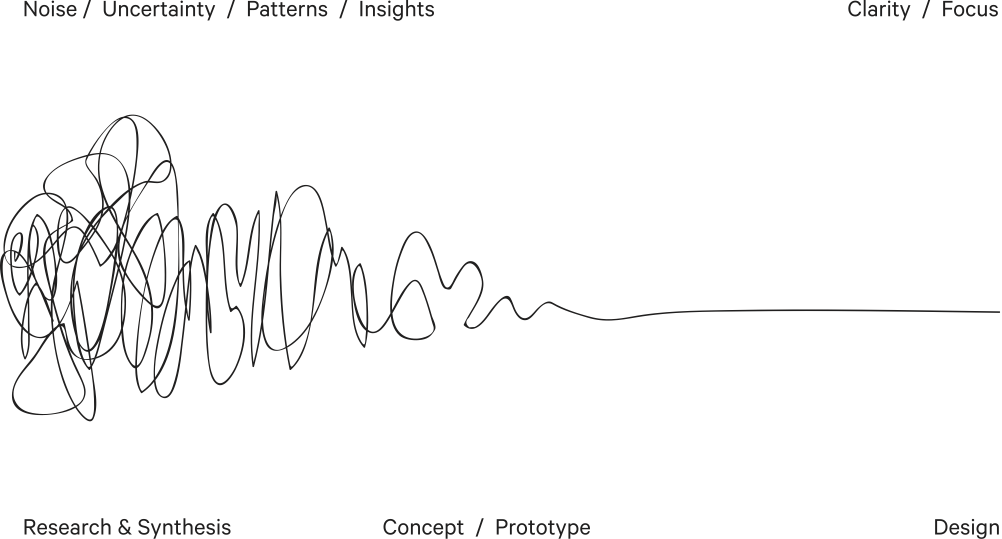Let’s face it. Coming up with a breakthrough marketing message to convey the value prop of your product or company is a messy process.

It’s complicated.
Everyone struggles to find the exact right words. You try to squeeze in everything needed to persuade your target audience. That’s a lot of pressure on a handful of sentences!
It’s time-consuming.
It requires writing and review cycles across many stakeholders. Messaging is often tackled as a final phase of a new release or major launch. When it happens at these late stages, it can feel like there’s never enough time to do it right. (And, what does it mean to do it right?)
It’s fraught with unknowns.
Even as experts on our tech and offerings, there are many open questions:
- Will your prospects get it?
- Will it resonate enough to create a call to action?
- Will it box out your competition or give them confidence?
- Will the product owner and head of sales agree on what’s most important?
The good news?
Being messy is a good thing.
Why?
Because like any design process, developing a meaningful marketing message or product narrative is a journey. One that tends to begin as a mess and (if done right) ends with a breakthrough.
There’s no better roadmap for this journey than Damien Newman’s Design Squiggle.

This simple and elegant metaphor is both a case study and a guide. It’s a reminder that you should embrace the mess as a crucial phase of creation and creativity.
Newman created this sketch as “a simple illustration of the design process.”
The Squiggle’s purpose was noble. It needed to convince his target audience of the value of the process of design.
In less than 30 seconds.
Why?
Because after previous attempts to create a breakthrough moment with his prospective clients, Newman needed a better way to convey a critical point: Design is more than just “the simple act of making ordinary things pretty.”
He initially used factual design school language and detailed descriptors in his pitch. But his audience had no interest in changing their perspective. His message wasn’t helping move the needle.
It wasn’t until he did this quick annotated sketch that the breakthrough took place.
Sound familiar?
We all fight a similar battle when attempting to create messaging that resonates and breaks through. Our prospects and customers are likely similar to Newman’s own (pun intended) clients.
Your process looks super messy at the start. It’s that chaotic tangle on the left side of Newman’s graphic. However, your stakeholders are expecting a straight path from point A-to-B.
Isn’t messaging just ”the simple act of making” pretty words on a PowerPoint?
A little bit—okay, a lot—of uncertainty is expected at the onset.
Embrace it!
Getting to the smooth phase of “Clarity / Focus” can be a lot easier if you keep a few things in mind.
First, all parties to the messaging process must see the “Squiggle” as a high-level journey map.
Use it to set expectations.
Leverage the sketch to reorient your constituents on where you are and where you need to go.
Turn to it when you’ve lost sight of the “clear” path to victory.
Newman couldn’t make it easier for you to do so. He’s created a website where you can download the graphic and use it under a Creative Commons license.
Next, follow these three tips to accelerate going from mess to breakthrough:
Keep it simple
Messaging can get convoluted and complex super quickly. I’ve always been amazed by how this happens before you realize it.
It sneaks in during the creation and feedback cycle. You get “oh, just add this word or phrase and you’re good” comments in the track changes. Before you know it, the few sentences end up saying nothing at all.
Don’t let it!
Remind yourself that your audience is made up of people and (most) people happen to talk without using $30 words and techno-jargon.
Why shouldn’t your messaging do the same?
Keep it focused
Yes! Your solution has a lot of moving parts and differentiated capabilities.
Guess what?
Your audience doesn’t have time for you to “ship your source code as your marketing!”
Get into their mindset and identify the one thing that is the most important.
How do you do this?
Simple: understand their current pain points, needs, and desires. Look back at the full buffet of features you have made available and find the one (yes, one) that will fill them with comfort for the most pressing of their challenges. Lead with that to win hearts and minds.
You’ll have plenty of time to demonstrate your ongoing value beyond this first one.
If your target audience can’t figure out why it matters to them because you’ve clobbered them with capabilities, they won’t bother spending any time at all.
Keep getting feedback
I was once asked by a startup founder, “do you think this is a compelling solution?” While she was practicing this principle, my response was “I don’t know, because I’m not the customer.”
Messaging efforts do spend a lot of time getting feedback through working sessions, executive reviews, and comments made in shared framework docs. However, it’s important to remember that your peers aren’t the buyer. They are not the target.
Go ask a customer or a partner for the feedback!
Your customers and partners want you to succeed. There’s more upside getting feedback from this group early and often to go from the uncertainty to the breakthrough.
I often hear hesitation like: “The messaging isn’t perfect yet. They might laugh at us!”
They won’t. They will make it reality-based and better! Of course, you need to choose your reviewers wisely. Nevertheless, you can rest assured these groups are more invested in your success than finding the best meme to crush your confidence.
Together these three tips and The Design Squiggle are great tools to eliminate your fears of getting muddied when crafting meaningful messaging.
Don’t worry, breakthroughs have a way of cleaning up the mess that gets created on your way to success.


